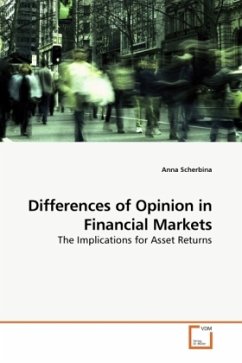How are asset prices determined when investors disagree about the firm valuation? Prof. Scherbina shows that market prices end up being too high, reflecting the more optimistic views. The reason is that, while optimistic investors can express their opinions freely by buying the shares of the firms they favor, pessimistic investors are often prevented from selling due to widespread short-sale constraints. Stock prices, initially too high, eventually correct down as more information comes out and forces optimists to revise their valuations downwards. Hence, measures that capture the level of investor disagreement, such as dispersion in analysts forecasts, also predict future underperformance. Furthermore, she presents evidence that equity analysts are at least partly to blame for the initial mispricing, as they tend to withhold negative information from investors under pressure from firm management. Yet, it is possible to quantify the amount of withheld negative information from the statistical properties of analysts forecasts. The bottom line is that investors should stay away from stocks that rank high on investor disagreement and measures of withheld negative information.
Bitte wählen Sie Ihr Anliegen aus.
Rechnungen
Retourenschein anfordern
Bestellstatus
Storno








